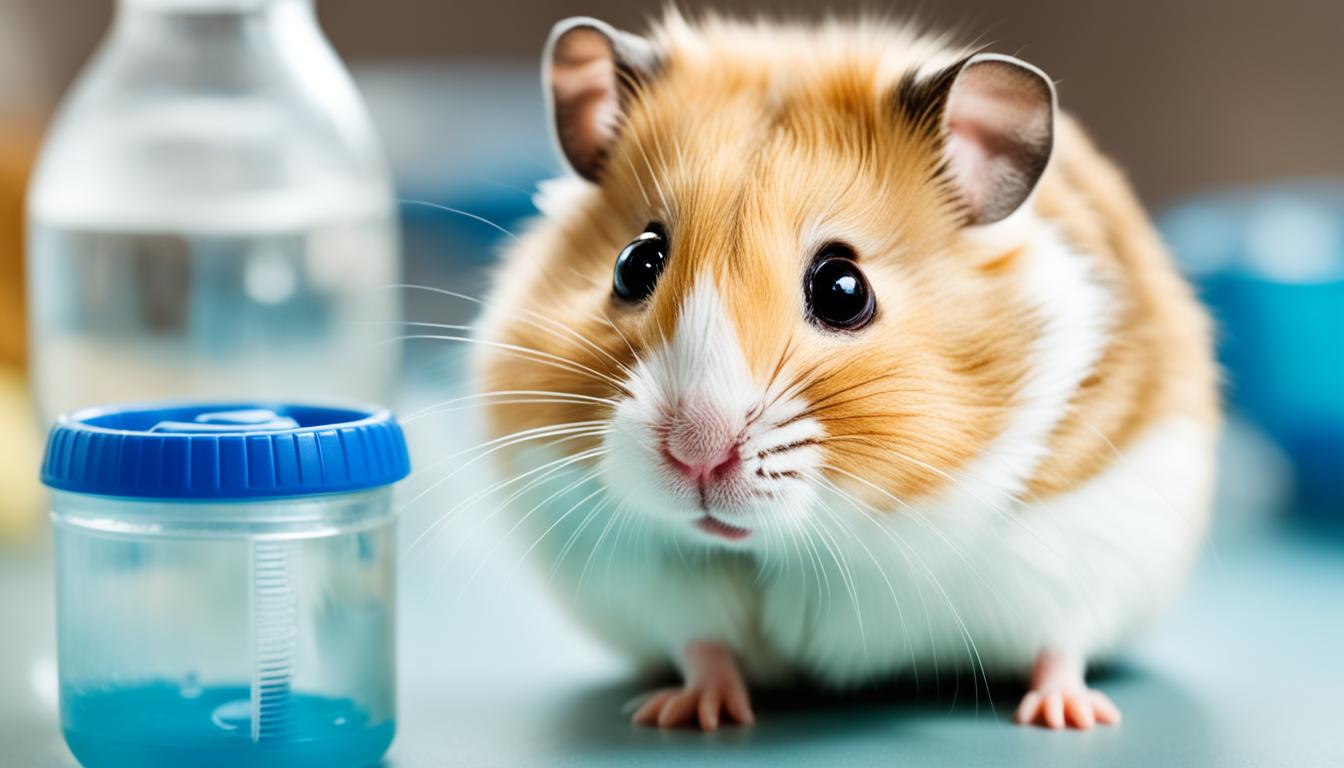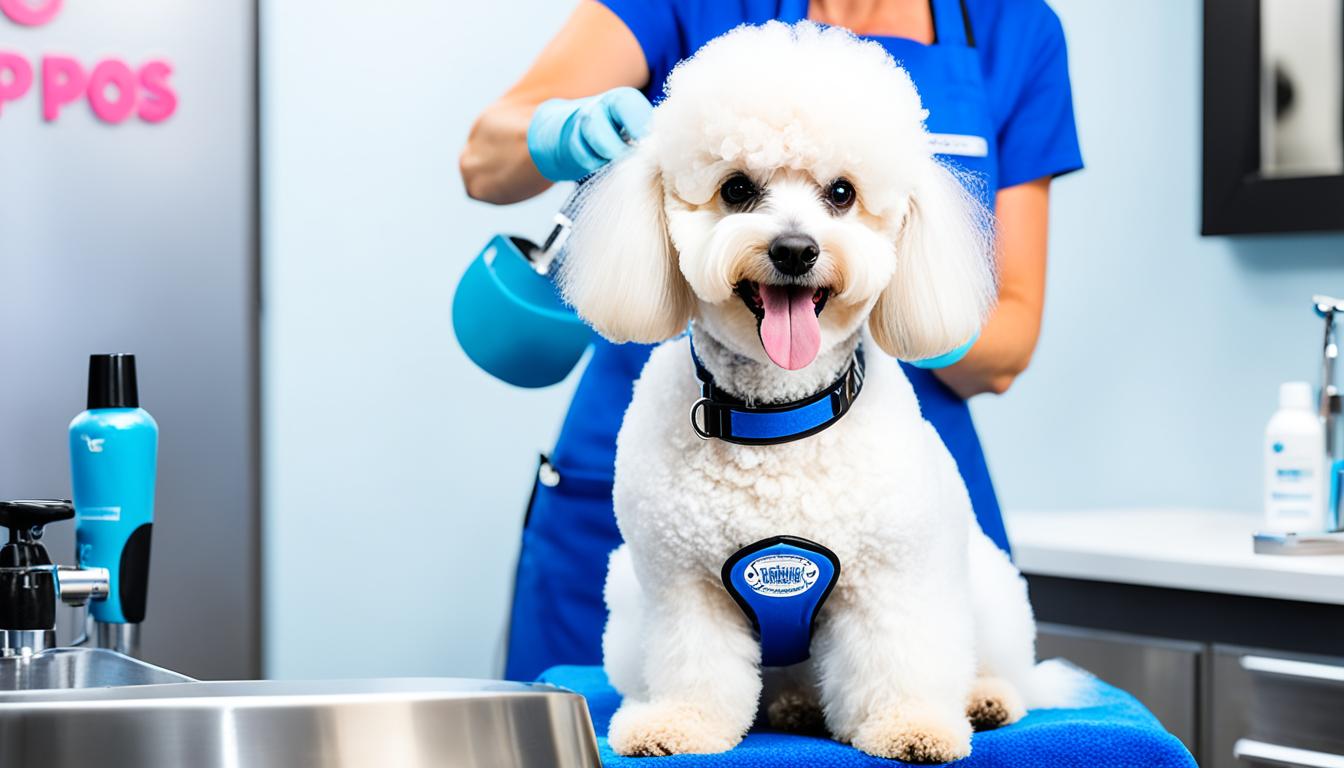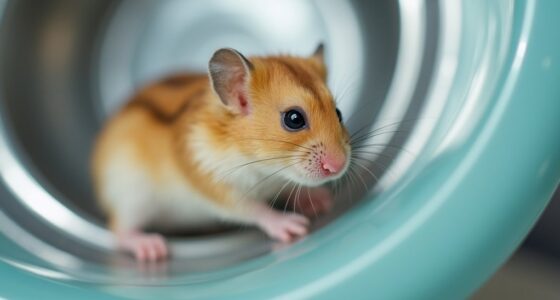Did you realize that hamsters typically have a short lifespan? On average, these cute little pets only live for 1.5 to 3 years. It is crucial for hamster owners to be able to recognize signs that their furry companion may be approaching the end of its life. By understanding these important signs, you can make sure to offer the needed care and comfort to your hamster during its last days.
Key Takeaways:
- Hamsters have a short lifespan, typically living for 1.5 to 3 years.
- Recognizing signs of a dying hamster is crucial for providing appropriate care.
- Observing changes in behavior, eating habits, and activity level can indicate a hamster’s declining health.
- Diarrhea, skin and fur abnormalities, respiratory issues, and hibernation-like states should be monitored closely.
- If you notice concerning signs, it’s important to seek veterinary care for your hamster.
Spend Time with Your Hamster Every Day
Building a strong bond with your hamster involves spending quality time with them every day. By doing so, you can familiarize yourself with their normal behavior and promptly identify any changes that might indicate potential health issues or the final stages of their life.
Establishing a routine for spending time with your hamster will allow you to observe their behavior closely. Take note of how active and playful they usually are, as well as their eating and grooming habits. This baseline understanding of their normal behavior will enable you to notice any deviations or abnormalities.
During your daily interactions with your furry friend, pay attention to their energy levels and enthusiasm. A sudden decrease in activity, lethargy, or a lack of interest in their usual activities could be a sign that something is amiss. Keep an eye out for unexplained weight loss or changes in the quality of their fur as well.
Creating a Bond:
Interacting with your hamster in a nurturing and stimulating environment is key to building a strong bond. Offer them various toys, tunnels, and exercise wheels to keep them entertained, ensuring their physical and mental well-being. Engaging in gentle petting sessions and providing treats can also help strengthen the bond between you and your pet.
“Spending time with your hamster on a daily basis not only allows you to enjoy their company but also helps you monitor their well-being and detect any potential health issues early on.”
Remember that hamsters are nocturnal creatures, so it’s best to spend time with them in the evening or during their peak activity hours. Be patient, as it may take some time for your hamster to become comfortable with you and their new surroundings. Over time, your consistent care and attention will nurture a stronger bond and a deeper level of trust between you.
Taking a Moment to Observe:
While engaging with your hamster, take a pause to observe their behavior closely. Look for any signs of distress or discomfort, such as excessive scratching, biting, or restlessness. Notice if their normal eating patterns change or if they exhibit abnormal behaviors like aggression or excessive grooming.
By spending regular, uninterrupted time with your hamster and paying attention to their behavior, you become attuned to their needs and can quickly recognize any shifts or changes. This heightened awareness enables you to take prompt action and seek medical attention if necessary.
| Normal Hamster Behavior | Changes to Watch For |
|---|---|
| Active and playful | Lethargy and reduced activity |
| Consistent eating patterns | Loss of appetite or refusing to eat |
| Healthy-looking fur and skin | Hair loss, red or flaky skin |
| Engages in regular grooming | Excessive grooming or self-neglect |
Observe Your Hamster’s Eating Habits
A healthy hamster will have a regular eating pattern and consume food throughout the day. Monitoring their eating habits is crucial to ensure their well-being. Any changes in their eating behavior can indicate potential health problems or the later stages of their life.
If you notice a decrease in appetite or if your hamster refuses to eat altogether, it is important to pay attention and take appropriate action. Consultation with a veterinarian may be necessary in such cases to rule out any underlying medical conditions.
Common Changes in Eating Behavior:
- Loss of interest in food: Your hamster may show a sudden disinterest in their favorite treats or regular meals.
- Reduced food intake: Your hamster may eat significantly less food than usual.
- Selective eating: Your hamster may only eat certain types of food and disregard others.
- Weight loss: If your hamster is not eating enough, they may experience noticeable weight loss.
It is essential to document any changes in your hamster’s eating habits and share this information with your veterinarian. A comprehensive examination can help identify potential health issues and ensure appropriate treatment.
Remember, changes in eating behavior are an important indicator of your hamster’s health. Timely intervention and care can improve their overall well-being and quality of life.

| Signs of Healthy Eating Habits | Signs of Unhealthy Eating Habits |
|---|---|
| Your hamster eats regularly throughout the day. | Your hamster shows a decrease in appetite or stops eating altogether. |
| Your hamster maintains a stable weight. | Your hamster experiences noticeable weight loss. |
| Your hamster shows excitement and enthusiasm during feeding times. | Your hamster displays disinterest or ignores their food. |
| Your hamster consumes a well-balanced diet. | Your hamster becomes selective and refuses certain foods. |
Observe Your Hamster’s Activity Level
Hamsters are typically active creatures, especially during the night. A lively and playful hamster is a sign of good health and well-being. However, if you notice a significant decrease in your hamster’s activity levels, it may be a cause for concern.
When a hamster becomes lethargic or excessively sleepy, it could indicate an underlying health issue or even that they are nearing the end of their life. Pay close attention to your hamster’s behavior over a period of time and look out for the following signs:
- Excessive sleeping or prolonged periods of inactivity
- A lack of interest in toys or playtime
- Reluctance to explore their environment
If your hamster is displaying these signs consistently, it is important to seek veterinary care as soon as possible. A veterinarian will be able to assess your hamster’s overall health and provide appropriate treatment if necessary.
Remember, every hamster is unique, and their activity levels may vary. However, a noticeable decrease in playfulness and a lack of engagement with their surroundings could be a cause for concern. Always trust your instincts as a pet owner and take action if you feel something is amiss.
In the next section, we will discuss another crucial aspect of monitoring your hamster’s health: checking for diarrhea.
Check for Diarrhea
Diarrhea in hamsters is a common illness, often referred to as “wet tail.” This condition is characterized by loose, watery stools and can be accompanied by a mucus-like substance around the base of the hamster’s tail. If you notice hamster diarrhea, it is important to take immediate action as it could indicate the presence of wet tail, which is a serious infection.
Diarrhea in hamsters can be caused by a variety of factors, including bacterial or viral infections, changes in diet, stress, or underlying health issues. It is crucial to monitor your hamster for any changes in their eating and activity levels, as diarrhea is often accompanied by a loss of appetite and decreased energy.
If you suspect your hamster has diarrhea, it is recommended to consult a veterinarian who specializes in small animals. They will be able to provide a proper diagnosis and recommend appropriate treatment options. Prompt veterinary care is essential to prevent further complications and ensure the well-being of your hamster.
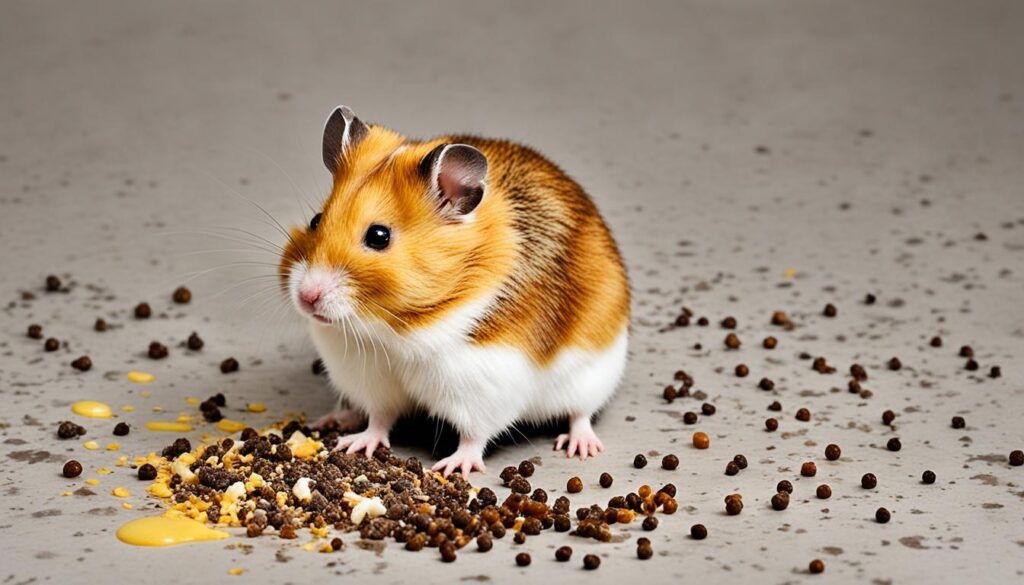
Common Symptoms of Hamster Diarrhea:
- Loose, watery stools
- Mucus-like substance around the base of the tail
- Loss of appetite
- Decreased energy and activity levels
Preventing Hamster Diarrhea:
While some cases of diarrhea in hamsters may be unavoidable, there are steps you can take to minimize the risk:
- Provide a balanced diet consisting of high-quality hamster pellets, fresh vegetables, and occasional treats.
- Avoid sudden changes in diet, as this can upset your hamster’s digestive system.
- Ensure your hamster has access to fresh, clean water at all times.
- Maintain a clean and stress-free environment for your hamster, as stress can contribute to gastrointestinal issues.
- Regularly clean your hamster’s cage to reduce the build-up of bacteria and maintain good hygiene.
Look at Your Hamster’s Skin and Fur
When it comes to your hamster’s health, it’s important to pay attention to their skin and fur. Changes or abnormalities in their skin and fur could be indicators of underlying health problems. Some common issues that hamsters may experience include redness, swelling, abscesses, or flaky skin. These symptoms may suggest skin infections or other dermatological conditions that require proper care and treatment.
If you notice that your hamster’s fur suddenly starts to thin or they develop wet or matted fur around their belly and tail, it could be a sign of fur loss in hamsters. This can be caused by various factors, including stress, poor nutrition, or even parasitic infestations. It’s essential to address these issues promptly to prevent further discomfort and potential complications.
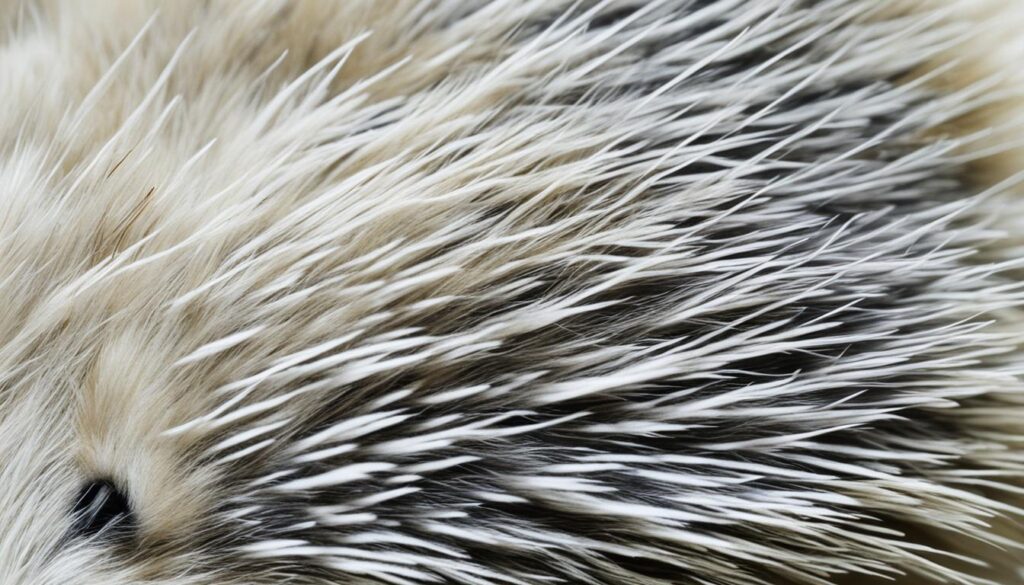
In some cases, hamsters may also exhibit fur chewing or self-mutilation behavior, which can lead to bald patches or damage to their skin. This behavior is often the result of stress, boredom, or an underlying medical condition. Consulting with a veterinarian is crucial to identify the underlying cause and provide appropriate treatment.
It’s essential to monitor your hamster’s skin and fur regularly to detect any changes or abnormalities. If you notice any concerning signs, it’s recommended to seek veterinary care for a proper diagnosis and treatment plan.
Look at Your Hamster’s Face, Mouth, and Eyes
When observing your hamster’s health, it’s essential to pay close attention to their face, mouth, and eyes. These areas can provide valuable insights into your furry friend’s well-being.
Checking for Respiratory Issues
If your hamster has a runny nose, it may be a sign of a respiratory issue. This could indicate a cold or another respiratory illness that requires attention. Additionally, their eyes may appear red and inflamed, which could be a symptom of the same respiratory problem. It’s essential to monitor these symptoms closely and seek veterinary care if necessary.
Examining the Cheek Pouches
Your hamster’s cheek pouches play an essential role in storing food. However, they can also be prone to swelling and infection. Carefully examine your hamster’s cheek pouches for any signs of swelling or discomfort. If you notice any abnormalities, it’s crucial to consult a veterinarian for further evaluation and treatment.
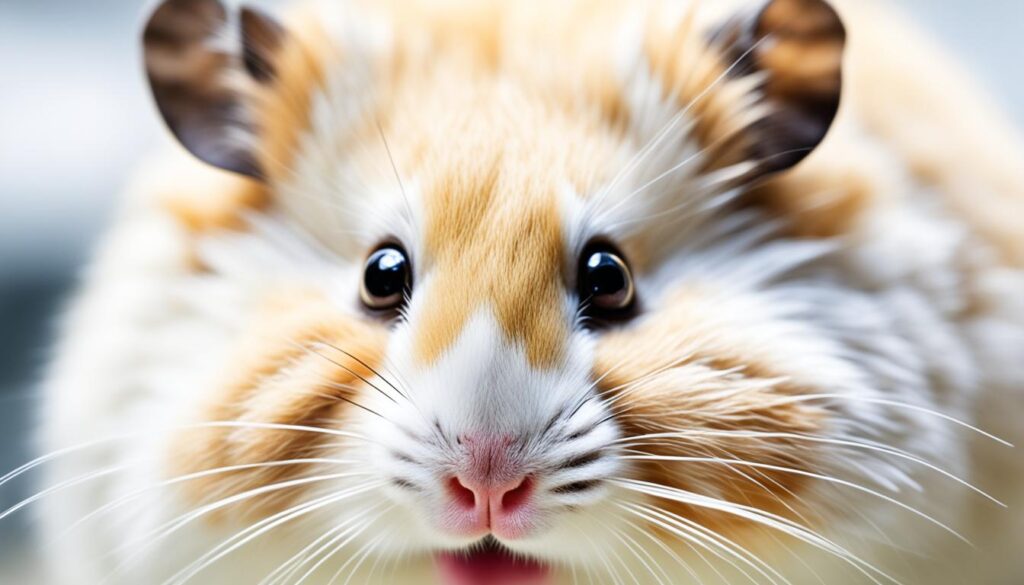
| Common Signs to Observe | Possible Implications |
|---|---|
| Puffy cheeks or swelling in the cheek pouches | Possible infection or dental issues |
| Runny nose | Potential respiratory illness or cold |
| Red and inflamed eyes | Indication of a respiratory problem |
By closely examining your hamster’s face, mouth, and eyes, you can detect potential health issues early on and ensure they receive the necessary care. Regular check-ups with a veterinarian are crucial for maintaining your hamster’s overall well-being.
Recognizing Hibernation vs. Death
It’s important to be able to distinguish between hibernation and death in hamsters. Cold temperatures can trigger hibernation in these small creatures, causing them to appear unresponsive and still.
If you suspect that your hamster may be hibernating, there are a few signs to look out for:
- Twitching Whiskers: Observe if your hamster’s whiskers are moving. Even in hibernation, hamsters may occasionally twitch their whiskers.
- Breathing: Gently watch for any signs of breath. If your hamster is hibernating, you may be able to see slight movements indicating breathing.
To determine whether your hamster is in hibernation or has passed away, it’s essential to warm up their environment. Provide a cozy and comfortable area with sufficient warmth, such as a heat pad or a warm water bottle wrapped in a towel. Place this near them without directly applying it to their body. After warming up the environment, continue observing your hamster for any signs of activity, such as movement or response. If your hamster shows no signs of life even after being warmed up, it may indicate that they have passed away.
“Recognizing hibernation in hamsters can help avoid unnecessary panic and provide the appropriate care when needed.”
In situations where you are uncertain whether your hamster is hibernating or deceased, it is always advisable to consult a veterinarian for further guidance and professional advice.
Hibernation vs. Death: A Quick Comparison
| Hibernation | Death |
|---|---|
| Hamster may appear unresponsive and still | No signs of movement or response |
| Whiskers may twitch occasionally | No visible whisker movement |
| May show slight signs of breathing | No signs of breath |
| Can be observed in warm and cozy environments | No response even after warming up the environment |

Seeking Veterinary Care
If you notice any concerning signs or changes in your hamster’s health and behavior, it is crucial to seek professional veterinary care. Hamsters are delicate creatures, and their health can deteriorate rapidly if left untreated. Consulting a vet who specializes in veterinary care for hamsters is the best course of action to ensure your furry friend receives proper medical attention. The expertise of a vet can help diagnose the underlying issue accurately and provide appropriate treatment.
When you visit the vet, be prepared to provide them with a detailed list of symptoms and behaviors you have observed in your hamster. This information can assist the vet in making an accurate diagnosis and designing a suitable treatment plan. It is essential to be observant and document any changes in your hamster’s behavior, such as appetite loss, lethargy, or unusual discharge.
Remember, as a responsible pet owner, your hamster’s health and well-being are your top priorities. Don’t hesitate to reach out to a veterinarian if you notice any signs of illness or distress in your hamster. Veterinary care ensures that your hamster receives the best possible medical attention and increases their chances of recovery.
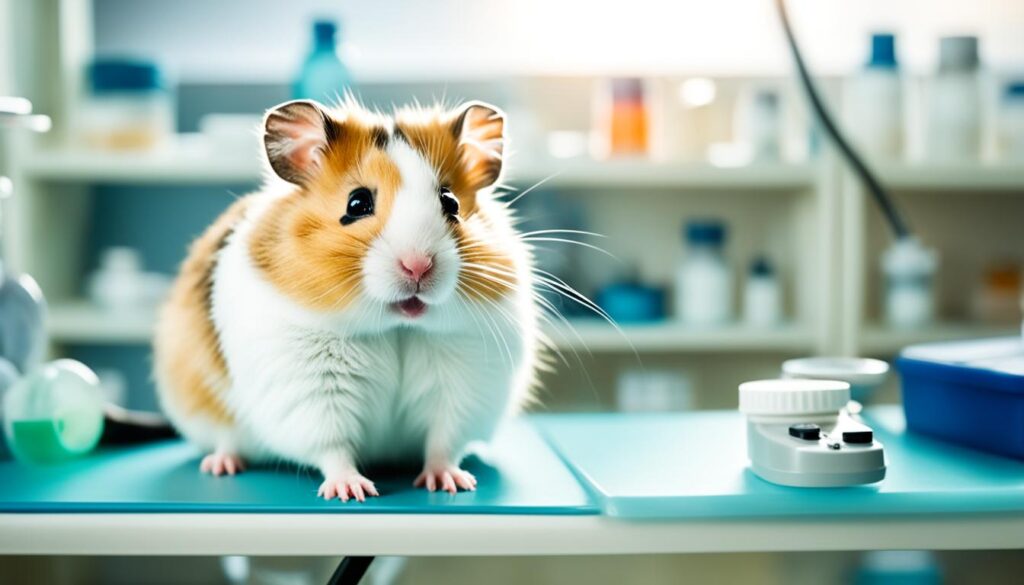
Why Consult a Vet for a Sick Hamster?
Hamsters have unique medical needs, and consulting a vet who specializes in their care is essential for several reasons:
- Expertise: Vets who specialize in small animals, including hamsters, have in-depth knowledge of their physiology, common health issues, and treatment protocols.
- Accurate Diagnosis: A vet can perform a thorough examination and run diagnostic tests to identify the underlying cause of your hamster’s illness. This helps in providing targeted treatment.
- Appropriate Treatment: Vets can prescribe medication or recommend specific dietary changes to address your hamster’s health issues. They can also offer advice on providing supportive care at home.
- Preventive Care: Regular visits to the vet allow for preventive measures to keep your hamster healthy and detect any potential issues early on.
Consulting a veterinarian who specializes in hamster care ensures that your furry friend receives the highest standard of veterinary care and increases their chances of a full recovery. Don’t hesitate to seek professional help when your hamster’s health is at stake.
Conclusion
Recognizing the signs that your hamster may be dying is essential to ensure their comfort and well-being in their final days. By closely monitoring their behavior, eating habits, and overall health, you can take the necessary steps in providing the care they need.
When it comes to your hamster’s health, it is crucial to seek veterinary care and guidance. A qualified veterinarian can offer professional advice and treatment options, ensuring the best possible outcome for your beloved pet.
Remember, your hamster’s well-being should be the top priority. By being vigilant in observing any changes, seeking expert advice, and providing appropriate care, you can help ensure their comfort and quality of life until the end.
